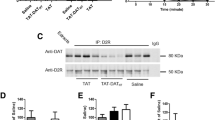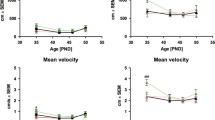Abstract
Sarizotan 1-[(2R)-3,4-dihydro-2H-chromen-2-yl]-N-[[5-(4-fluorophenyl) pyridin-3-yl]methyl] methenamine, showed an in vivo pharmaco-EEG profile resembling that of methylphenidate which is used in attention deficit/hyperactivity disorder (ADHD). In turn, we tested sarizotan against impulsivity in juvenile rats measuring the choice for large delayed vs. a small immediate reward in a T-maze and obtained encouraging results starting at 0.03 mg/kg (plasma levels of ~11 nM). Results from rats treated neonatally with 6-hydroxydopamine (6-OHDA), also supported anti-ADHD activity although starting at 0.3 mg/kg. However, microdialysis studies revealed that free brain concentration of sarizotan at active doses were below its affinity for 5-HT1A receptors, the assumed primary target. In contrast, electrophysiological experiments in mid-brain Raphé serotonergic cells paralleled by plasma sampling showed that there was ~60 % inhibition of firing rate—indicating significant activation of 5-HT1A receptors—at a plasma concentration of 76 nM. In line with this, we observed that sarizotan concentrations in brain homogenates were similar to total blood levels but over 500 fold higher than free extracellular fluid (ECF) concentrations as measured using brain microdialysis. These data suggest that sarizotan may have potential anti-ADHD effects at low doses free of the previously reported side-effects. Moreover, in this case a classical pharmacokinetic–pharmacodynamic relationship based on free brain concentrations seems to be less appropriate than target engagement pharmacodynamic readouts.








Similar content being viewed by others
References
Assie MB, Dominguez H, Consul-Denjean N, Newman-Tancredi A (2006) In vivo occupancy of dopamine D2 receptors by antipsychotic drugs and novel compounds in the mouse striatum and olfactory tubercles. Naunyn-Schmiedebergs Archiv Pharmacol 373:441–450
Bartoszyk GD, Van Amsterdam C, Greiner HE, Rautenberg W, Russ H, Seyfried CA (2004) Sarizotan, a serotonin 5-HT1A receptor agonist and dopamine receptor ligand. 1. Neurochemical profile. J Neural Trans 111:113–126
Bizot JC, Chenault N, Houze B, Herpin A, David S, Pothion S, Trovero F (2007) Methylphenidate reduces impulsive behaviour in juvenile Wistar rats, but not in adult Wistar, SHR and WKY rats. Psychopharmacology 193:215–223
Bizot JC, David S, Trovero F (2011) Effects of atomoxetine, desipramine, d-amphetamine and methylphenidate on impulsivity in juvenile rats, measured in a T-maze procedure. Neurosci Lett 489:20–24
Brus R, Kostrzewa RM, Perry KW, Fuller RW (1994) Supersensitization of the oral response to SKF 38393 in neonatal 6-hydroxydopamine-lesioned rats is eliminated by neonatal 5,7-dihydroxytryptamine treatment. J Pharmacol Exp Therap 268:231–237
Curatolo P, Paloscia C, D’Agati E, Moavero R, Pasini A (2010) The neurobiology of attention deficit/hyperactivity disorder. Eur J Paediatr Neurol 13:299–304
Davids E, Zhang K, Tarazi FI, Baldessarini RJ (2002) Stereoselective effects of methylphenidate on motor hyperactivity in juvenile rats induced by neonatal 6-hydroxydopamine lesioning. Psychopharmacology 160:92–98
Dimpfel W (2005) Pharmacological modulation of cholinergic brain activity and its reflection in special EEG frequency ranges from various brain areas in the freely moving rat (Tele-Stereo-EEG). Eur Neuropsychopharmacol 15:673–682
Dimpfel W (2007) Characterization of atypical antipsychotic drugs by a late decrease of striatal alpha1 spectral power in the electropharmacogram of freely moving rats. Br J Pharmacol 152:538–548
Dimpfel W (2008) Pharmacological modulation of dopaminergic brain activity and its reflection in spectral frequencies of the rat electropharmacogram. Neuropsychobiology 58:178–186
Dimpfel W (2013) Pharmacological classification of herbal extracts by means of comparison to spectral EEG signatures induced by synthetic drugs in the freely moving rat. J Ethnopharmacol 149:583–589
Dimpfel W, Spuler M, Koch R, Schatton W (1987) Radioelectroencephalographic comparison of memantine with receptor-specific drugs acting on dopaminergic transmission in freely moving rats. Neuropsychobiology 18:212–218
Fan X, Hess EJ (2007) D2-like dopamine receptors mediate the response to amphetamine in a mouse model of ADHD. Neurobiol Dis 26:201–211
Gallemann D, Wimmer E, Hofer CC, Freisleben A, Fluck M, Ladstetter B, Dolgos H (2010) In vitro characterization of sarizotan metabolism: hepatic clearance, identification and characterization of metabolites, drug-metabolizing enzyme identification, and evaluation of cytochrome p450 inhibition. Drug Metab Dispos 38:905–916
Goetz CG, Damier P, Hicking C, Laska E, Muller T, Olanow CW, Rascol O, Russ H (2007) Sarizotan as a treatment for dyskinesias in Parkinson’s disease: a double-blind placebo-controlled trial. Mov Disord 22:179–186
Goetz CG, Laska E, Hicking C, Damier P, Muller T, Nutt J, Warren Olanow C, Rascol O, Russ H (2008) Placebo influences on dyskinesia in Parkinson’s disease. Mov Disord 23:700–707
Goldman D, Lappalainen J, Ozaki N (1996) Direct analysis of candidate genes in impulsive behaviours. Ciba Found Symp 194:139–152
Kollins SH (2003) Comparing the abuse potential of methylphenidate versus other stimulants: a review of available evidence and relevance to the ADHD patient. J Clin Psychiatry 64(Suppl 11):14–18
Kostrzewa RM, Gong L (1991) Supersensitized D1 receptors mediate enhanced oral activity after neonatal 6-OHDA. Pharmacol Biochem Behav 39:677–682
Kostrzewa RM, Brus R, Kalbfleisch JH, Perry KW, Fuller RW (1994) Proposed animal model of attention deficit hyperactivity disorder. Brain Res Bull 34:161–167
Kostrzewa RM, Kostrzewa JP, Kostrzewa RA, Nowak P, Brus R (2008) Pharmacological models of ADHD. J Neural Trans 115:287–298
Krosser S, Tillner J, Fluck M, Ungethum W, Wolna P, Kovar A (2007) Pharmacokinetics of sarizotan after oral administration of single and repeat doses in healthy subjects. Int J Clin Pharmacol Ther 45:271–280
Kuenzel HE, Steiger A, Held K, Antonijevic IA, Frieboes RM, Murck H (2005) Changes in sleep electroencephalogram and nocturnal hormone secretion after administration of the antidyskinetic agent sarizotan in healthy young male volunteers. Psychopharmacology 180:327–332
Kuzhikandathil EV, Bartoszyk GD (2006) The novel antidyskinetic drug sarizotan elicits different functional responses at human D2-like dopamine receptors. Neuropharmacology 51:873–884
Kuzhikandathil EV, Oxford GS (2002) Classic D1 dopamine receptor antagonist R-(+)-7-chloro-8-hydroxy-3-methyl-1-phenyl-2,3,4,5-tetrahydro-13H-benzaze pine hydrochloride (SCH23390) directly inhibits G protein-coupled inwardly rectifying potassium channels. Mol Pharmacol 62:119–126
Leo D, Adriani W, Cavaliere C, Cirillo G, Marco EM, Romano E, di Porzio U, Papa M, Perrone-Capano C, Laviola G (2009) Methylphenidate to adolescent rats drives enduring changes of accumbal Htr7 expression: implications for impulsive behavior and neuronal morphology. Genes Brain Behav 8:356–368
Markowitz JS, DeVane CL, Pestreich LK, Patrick KS, Muniz R (2006) A comprehensive in vitro screening of d-, l-, and dl-threo-methylphenidate: an exploratory study. J Child Adolesc Psychopharmacol 16:687–698
May DE, Kratochvil CJ (2010) Attention-deficit hyperactivity disorder: recent advances in paediatric pharmacotherapy. Drugs 70:15–40
Newman-Tancredi A, Assie MB, Leduc N, Ormiere AM, Danty N, Cosi C (2005) Novel antipsychotics activate recombinant human and native rat serotonin 5-HT1A receptors: affinity, efficacy and potential implications for treatment of schizophrenia. Int J Neuropsychopharmacol 8:341–356
Oades RD (2008) Dopamine-serotonin interactions in attention-deficit hyperactivity disorder (ADHD). Prog Brain Res 172:543–565
Olanow CW, Damier P, Goetz CG, Mueller T, Nutt J, Rascol O, Serbanescu A, Deckers F, Russ H (2004) Multicenter, open-label, trial of sarizotan in Parkinson disease patients with levodopa-induced dyskinesias (the SPLENDID Study). Clin Neuropharmacol 27:58–62
Park YH, Lee KK, Kwon HJ, Ha M, Kim EJ, Yoo SJ, Paik KC, Lim MH (2013) Association between HTR1A gene polymorphisms and attention deficit hyperactivity disorder in Korean children. Genet Test Mol Biomarkers 17:178–182
Pattij T, Vanderschuren LJ (2008) The neuropharmacology of impulsive behaviour. Trends Pharmacol Sci 29:192–199
Paxinos G, Watson C (1986) The rats brain in stereotaxic coordinates. Academic Press, Nww York
Rabiner EA, Gunn RN, Wilkins MR, Sedman E, Grasby PM (2002) Evaluation of EMD 128 130 occupancy of the 5-HT1A and the D2 receptor: a human PET study with [11C]WAY-100635 and [11C]raclopride. J Psychopharmacol 16:195–199
Rascol O, Damier P, Goetz C, Hicking C, Hock K, Müller T, Olanow W, Russ H (2006) A large phase III study to evaluate the SAFETY and Efficacy of Sarizotan in the Treatment of Levodopa-induced Dyskinesia Associated with Parkinson´s Disease—the PADDY-1 Study. Movement Disorders. 10th International Congress of Parkinson’s Disease and Movement Disorders, Kyoto, Japan
Russell VA (2007) Neurobiology of animal models of attention-deficit hyperactivity disorder. J Neurosci Methods 161:185–198
Tripp G, Wickens JR (2009) Neurobiology of ADHD. Neuropharmacology 57:579–589
Valastro B (2012) Sarizotan for use in the treatment of attention deficit hyperactivity disorder (adhd). Google Patents
Yates JR, Perry JL, Meyer AC, Gipson CD, Charnigo R, Bardo MT (2014) Role of medial prefrontal and orbitofrontal monoamine transporters and receptors in performance in an adjusting delay discounting procedure. Brain Res 1574:26–36
Zhang K, Davids E, Tarazi FI, Baldessarini RJ (2002) Effects of dopamine D4 receptor-selective antagonists on motor hyperactivity in rats with neonatal 6-hydroxydopamine lesions. Psychopharmacology 161:100–106
Acknowledgments
We would like to thank Anita Vanaga, Christiane Güntner and Werner Feser-Zügner for their support in sarizotan analysis in biological samples and Sabrina David and Sabine Justal for their excellent technical work in the T-maze experiment. Lutz Franke and Barbara Valastro are kindly acknowledged for their contribution to the coordination of experimental activities and providing the idea of ADHD testing respectively.
Author information
Authors and Affiliations
Corresponding author
Rights and permissions
About this article
Cite this article
Danysz, W., Flik, G., McCreary, A. et al. Effects of sarizotan in animal models of ADHD: challenging pharmacokinetic–pharmacodynamic relationships. J Neural Transm 122, 1221–1238 (2015). https://doi.org/10.1007/s00702-015-1392-6
Received:
Accepted:
Published:
Issue Date:
DOI: https://doi.org/10.1007/s00702-015-1392-6




